Site menu:
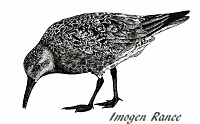
February 2018 Newsletter
Among Knots.
January Bird News.
Forthcoming Events.
Latest Newsletter.
Among Knots
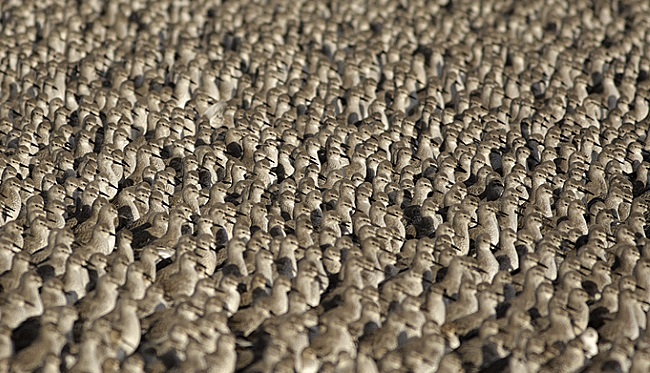
http://www.stevenround-birdphotography.com/
Bird migration is the one truly unifying
natural phenomenon in the world, stitching the continents together in a
way that even the great weather systems, which roar out from the poles
but fizzle at the equator, fail to do. It is an enormously complex
subject, perhaps the most compelling drama in all of natural
history. Scott Weidensaul
It is possible to write a short
description of bird migration that will read as if the subject is
completely understood, but this is true only in generalities. Only when
there is space for details can it be appreciated that underneath this
apparent certainty, there is a labyrinth of unresolved problems for
researchers to tackle.
Robert Burton
'Welcome to the world of wader research' I thought as both my feet and tripod sank six inches into thick estuarine mud, but despite the mud I was actually enjoying myself as I was Among Knots. There have been many wonderful experiences this winter with Knots but two stand out - the day I was sinking into the mud when several hundred birds were walking towards me, busy feeding, completely unfazed by my presence and I was so close I could almost touch them. The other was when 20,000 Knot were roosting in the channel off Tinker's Dell when a Peregrine flew by, it was a still day and the noise 40,000 wings made was just unbelievable. That day they didn't just disappear into the distance and many just hovered over the channel and I saw the peregrine fly right through the flock three times without catching anything, presumably the sheer number confusing it. Wonderful!
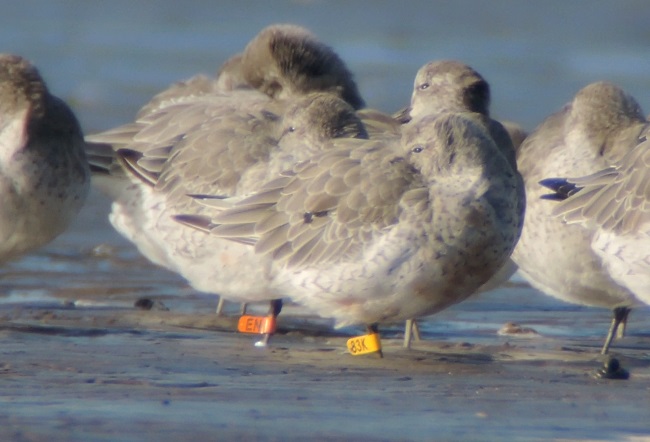
© Peter Knight
Following a big ringing effort in 2017
in Iceland and the Waddensee, and locally at Altcar on the Sefton
coast, many hours have been spent logging these colour-ringed birds as
part of the study into this species, specially those that visit the
Ribble and Dee estuaries. It is no exaggeration to say that this winter
has seen the most productive work ever on Knot in the UK. You may think
hundreds of volunteers have been involved in this work but we are just
a handful of enthusiasts with well over 90% of the records
collected by just myself and Steve Hinde here on the Dee Estuary, Peter
Knight and Rose Maciewicz on the Sefton coast from Southport
to Crosby, and Ed Keeble in Suffolk*. All this is eclipsed by Benjamin
Gnep who spent from 25th July to 15th October 2017 on the lonely island
of Griend in the Waddensee (Netherlands) where over 100,000 Knot
undergo moult. As Peter said when talking about Benjamin "there aren’t
many people like him who would happily spend all day every day for
months on a deserted sandbank reading Knot rings – apart from us, that
is!". During his 2017 stint Benjamin recorded 1,438 different
colour-ringed Knots, many of which we've subsequently seen here in the
north-west of England.
*which isn't to say other people haven't been collecting records and on the Dee estuary these include Matt Thomas, Richard de Feu, Allan Hitchmough, Elliot Montieth and Paul Ralston, and I know birders from Ireland, Morecambe Bay and NE Scotland have also sent records in.
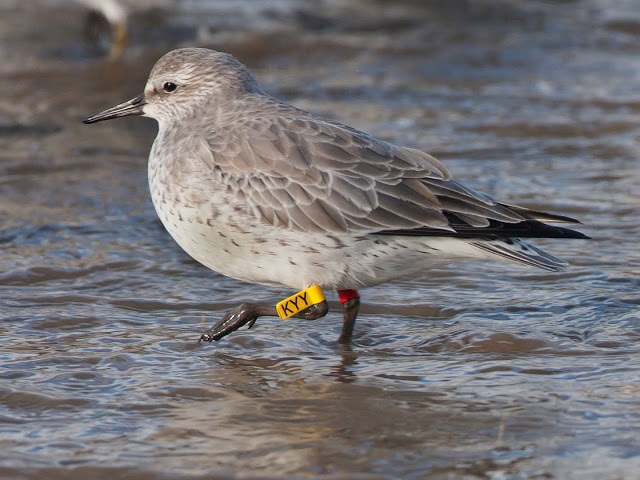
www.fromthemuddybanksofthedee.com
Here on the Dee estuary we've been involved in wader research, in the form of logging colour-ringed birds, for well over 10 years but with Knot only at the periphery as we rarely make it into double figures each year. Seven colour-ringed birds in the winter of 2016/17 was fairly typical and numbers of Knot on the estuary that winter, and the previous winter, were disappointingly low, so we weren't expecting anything different this winter - but we were wrong! There have been a lot of Knot around starting with an inland roost, a very unusual event in itself, at Caldy where they were present for several weeks in the autumn, then the winter brought over 20,000 Knot to Thurstaston where we have monitored them both roosting and feeding. The increase in the number of colour-ringed Knot, their location on the estuary close to the shore (and inland at Caldy) together with a big increase in observer effort has resulted in a huge jump in colour-ring sightings. Being able to follow individual birds, almost on a daily basis, is vitally important in our efforts to understand the movements and requirements of these birds.
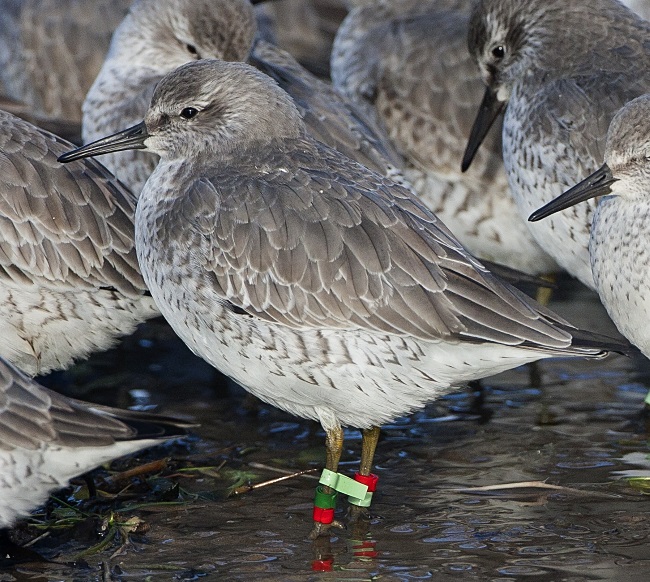
www.fromthemuddybanksofthedee.com
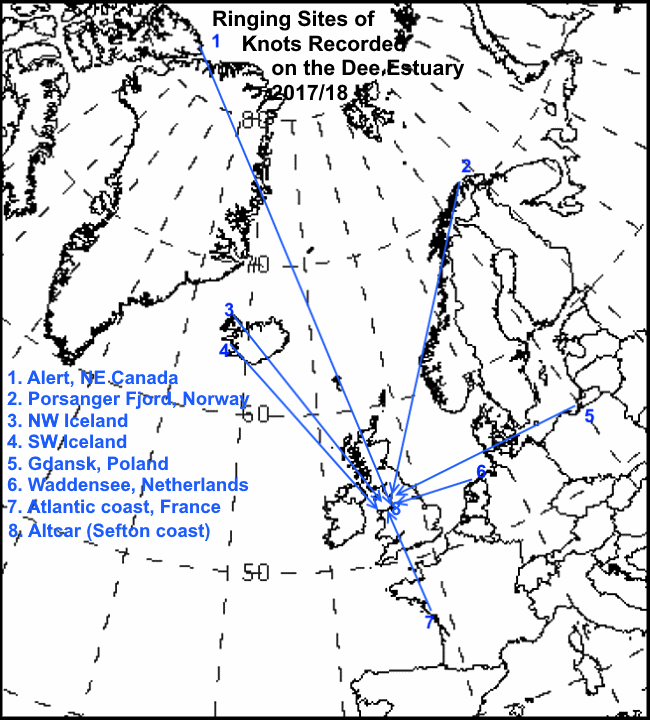
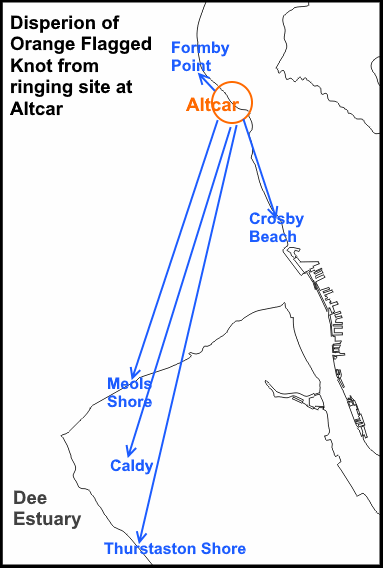
The maps show where the birds we have recorded where ringed, with various different ringing schemes, and below are some figures:
| Knot on the Dee Estuary September 2017 to Jan 2018 | |
| Total number of Observations of colour-ringed birds: | 960 |
| Individuals with Orange flags (ringed at Altcar Sep 2017): | 277 |
| Individuals with Yellow flags (ringed in SW Iceland May 2017): | 30 |
| Individuals with Yellow flags (ringed in NW Iceland May 2014): | 2 |
| Individuals with Yellow flags (ringed in N Norway): | 4 |
| Individuals ringed on the Waddensee, Netherlands: | 33 |
| Individuals ringed in Poland: | 1 |
| Individuals ringed in France: | 1 |
| Individuals ringed in NE Canada: | 1 |
Of the 519 birds ringed with an Orange flag at Altcar on September 22nd 2017 we have now recorded 53% of them on the Dee estuary and 54% between Crosby and Southport, with a total of 407 seen since September; this is a remarkable recovery rate considering these birds were ringed just five months ago. The only birds reported away from the area are just a handful at Morecambe Bay to the north and the east coast of Ireland to the south-west, with just one away from the Irish Sea in NE Scotland, so there has been hardly any dispersal through the winter other than to the Dee Estuary.
The interesting question now is what will these birds do in the spring? Previous experience suggests that the over-wintering flock effectively splits with some heading back east to the Waddensee whilst others first head north to the Ribble estuary in April before flying to Iceland in May where they moult into breeding plumage. They will be watched along the way and for the first time we should get a clear idea of the spring movements of 'our' Dee estuary birds, then we look forward to their return after the breeding season!
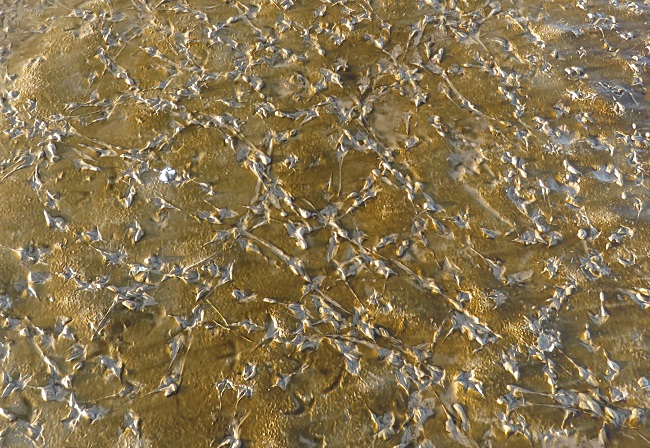
Acknowledgements:
1. You will see below reference to Benjamin Gnep's ring reading report titled 'Among Knots'. I loved the title so much I unashamedly used it for my article, but I'm sure Benjamin won't mind!
2. As well as the fellow colour-ring readers mentioned in the article acknowledgement and many thanks must go to all those ringers who ringed these birds in the first place. I know many ringing sessions in Iceland and Norway in particular were carried out in near freezing conditions over several hours under much pressure as the birds can only be held captive for a limited time.
3. Thanks in particular must go to Jim Wilson who has organised much of this colour ringing activity and has been studying Knots for many years, he is collating all the data for the Altcar, Iceland and Norwegian ringed birds. He started ringing waders back in the 1960s on the Dee Estuary with the Merseyside Ringing Group. Jim is currently the Colour Ring Coordinator for waders in Europe.
4. The other major player in colour ringing Knots is the shorebird group of the Royal Dutch Institute for Sea Research (NIOZ) who have been ringing Knots since 1998. Up to November 2017 a total of 8,270 have been colour ringed on the Dutch Waddensea, 3,330 in Mauritania, 133 in the German Waddensea, 645 on the Atlantic coast of France and 21 in Portugal. NIOZ is regarded as the most important organisation in the world when it comes to wader research with one member contributing more than most. I quote from Keith Woodley's excellent book 'Godwits' (2009): "One suspects the word 'prolific' could have been coined with eminent authority on shorebirds, Theunis Piersma, in mind. This Dutch biologist has over 570 books, papers, reports and reviews bearing his name, often as co-author, but many times as lead or sole author. Much of what we know of migratory shorebird biology is due to the work of Piersma and many colleagues around the world".
References and Further Reading:
1. Benjamin Gnep, 'Among Knots', Report about the results of two ring-reading seasons in autumn 2016 and 2017, Royal Dutch Institute for Sea Research, November 2017.
2. Richard Smith, Colour Ring Report
October 2017 Newsletter, www.deeestuary.co.uk/news. This
item gives some background for the 'Ribble Knot Project' including the
ringing of the Orange flagged birds in September 2017.
Jim Wilson has co-authored many papers on Knot migration and he was involved in the discovery that the Knot which stage in Northern Norway in May were not, as had been assumed, on their way to Siberia but instead flew west across the northern Atlantic to Greenland and eastern Canada to join the larger numbers which migrate through Iceland. Here are two articles:
2. Davidson, N.C. & J.R.
Wilson. 1992. The migration system of European-wintering Knots Calidris
canutus islandica. Wader Study Group Bulletin 64(Suppl.):
39–51.
3. Wilson, J.R. & P.S.
Tomkovich. 2017. Spring migration of Red Knot Calidris canutus subspecies
through N Europe. Wader Study 124(2): 125–133.
Recent work by NIOZ has shown that many Knot, including juveniles, fly from eastern Canada and Greenland straight to NW Europe after the breeding season rather than staging in Iceland:
4. Dietz, M.W. et.al, Do Red Knots (Calidris Canutus Islandica) Routinely Skip Iceland During Southward Migration?, The Condor 112(1):48-55, 2010.
5. In the winter of 2015/16 a Knot
(given the name of 'Paula') was tagged with a satellite
transmitter on the Waddensea, and has now been followed twice to NE
Canada and back. Click on the link below to download a PDF file which
describes the project and includes maps:
Eva
M.K. Kok, Paula 2.0: Second migratory track of red knot, 2017.
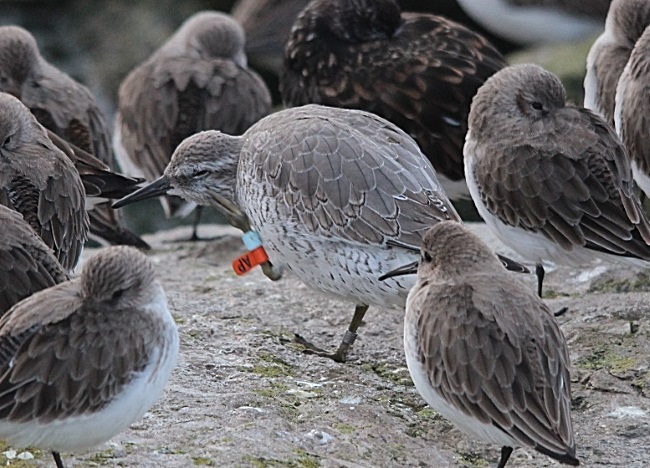
January Bird News
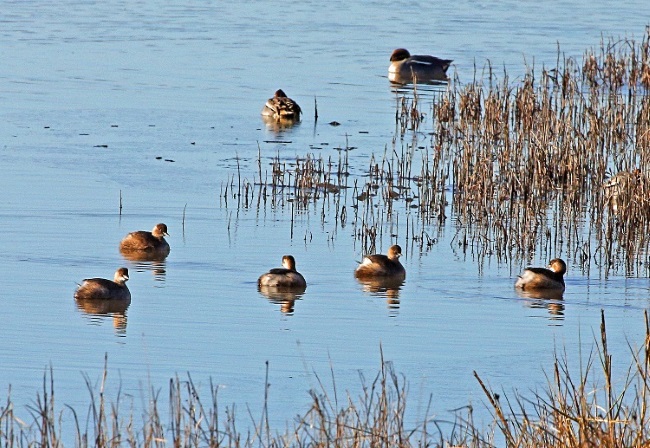
A high spring tide on the 4th produced an
excellent 12 Sort-eared Owls off Cottage Lane, Heswall, flushed from
their roost there and the highest number at that location for several
years. The same high tide resulted in over 10 Water Rails and 4 Great
White Egrets at Parkgate with six on the 7th. The same set of
tides saw good numbers of Purple Sandpipers on the pontoon on New
Brighton with max 13 on the 6th. A Bittern was spotted at Parkgate on a
couple of dates.
As far as I know there hasn't been any roost count of Marsh Harriers going into Neston Reed Bed but there have been good numbers recorded all month including 12 at Parkgate on the morning of the 27th. Max count of Hen Harriers was three, including a grey male.
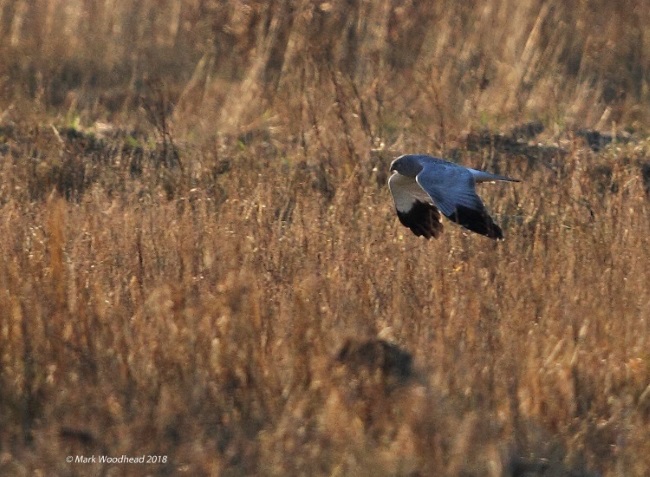
I don't know what the total count of
Pink-footed Geese is on the estuary but there has been much movement
with 3,000 flying north towards south Lancs on the 6th but there were
still 3,000 on Burton Marsh on the 8th. Over 1,000 (max 1,800) have
been roosting every night on the edge of Heswall
Marsh then
flying inland at first light to feed in various fields around Heswall
and Thurstaston. Nine Greenland White- fronted Geese were still at
Warren Farm until at least mid-month. Max count of Brent Geese around
Hilbre was 320 and it was good to see the small flock of six Eiders
present all month.
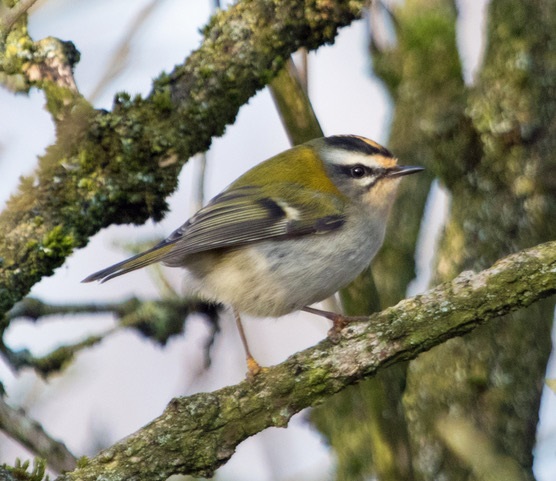
A Firecrest was a good find at Neston Sewage Works with one or two
Water Pipits there and at Neston Old Quay.
A Glaucous Gull was seen off the Connah's Quay Reserve and off Flint, and there were several Mediterranean Gulls scattered among the Black-headed Gull flocks in the wet fields in north Wirral. A Cattle Egret was recorded several times feeding with Little Egrets in fields by Puddington.
Top of Page
What to expect in February
Wader numbers will still be high and last year we had an early passage of several thousand Dunlins coming through with some amazing views of them on the rocks at West Kirby Marine Lake. There should also be many thousands of Knots, Grey Plover and Oystercatchers at the main high tide roost sites of Point of Ayr, West Kirby and Hoylake. Some years February brings a massive influx of gulls with Hilbre and north Wirral holding as many as 20,000 - mainly Herring Gulls but holding rarer species such as Caspian Gulls.
Out to sea we can get huge numbers of Scoters out in Liverpool Bay as they are on their way north after spending the winter further south - perhaps off West Africa but nobody really knows. Also a calm day will mean we will be able to get a good count of the wintering flock of Great Crested Grebes, one of the biggest in the country with 800+.
There will be mild days when there will be signs of spring with birdsong and drumming woodpeckers in the woods, it is not unknown for the first spring migrant to turn up before the end of the month - perhaps a very early Sand Martin.
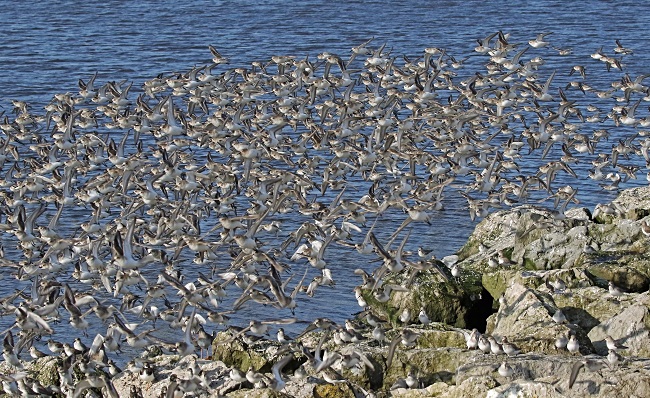
Top of Page
Forthcoming Events
February Highest Spring Tides (Liverpool)
Also
see Tides
page.
1st February, 11.35hrs (GMT), 9.9m.
2nd February, 12.21hrs (GMT), 10.0m.
3rd February, 13.06hrs (GMT), 9.9m.
Forthcoming Events
Organised by the Wirral
Ranger Service , Flintshire
Countryside Service and the
RSPB (Dee Estuary):
All these events and walks have bird interest, even those not
advertised specifically for birdwatching. No need to book for these
events unless specified - please check below.
Friday 2nd
February and Saturday 3rd February , High Tide Raptor Watch at Parkgate.
10.30am to 1.30pm.
Free.
For further details ring 0151 353 8478.
Come
along to the car park at the Old Baths for the chance of seeing a range
of birds of prey hunting over Parkgate Marsh. Hen and marsh harriers,
peregrines and merlins all spend the winter months on the estuary and
this is one of the best places to watch them, plus short-eared owls if
we're really lucky. January's big tides were helped by Storm Eleanor
but the tide reached the seawall and gave brilliant views of these
hunting raptors, plus plus hard-to-find birds like water rails, rock
pipits and lots of small mammals fleeing.
These biggest tides in
February offer the same spectacle, so why not venture out to try
witness all the drama. Low pressure and a westerly wind will help push
the tide and wildlife in close. There's also chance of seeing the great
range of ducks, geese, wading birds and egrets in big numbers as they
are pushed upstream by the rising tide.
There is free public
parking at the Old Baths car park (CH64 6RN) at the north end of The
Parade, and the Wirral Country Park car park on Station Road (CH64
6QJ). There are public toilets at Mostyn Square in the middle of The
Parade, and a number of pubs and cafes.
Tide times: Friday 2 February, 10.0m at 12.21pm; Saturday 3 February,
9.9m at 1.06pm.
Saturday 17th
February, Hoylake High Tide
Birdwatch.
10.30am-12.30pm
Price: Free
Join
the Coastal Rangers, the Dee Estuary Voluntary Wardens and the RSPB on
this high tide birdwatch at Hoylake promenade to see large flocks of
wading birds as they gather and roost on the shore. We should see
dunlin and knot numbers at their peak as we reach the end of winter,
plus a range of other wading birds for whom this North Wirral coastline
is a vitally important home. With a rising tide, we should see the
birds at close quarters as they roost and feed.
Beginners welcome
- a great opportunity to brush up on your wader ID with knowledgeable
guides. Dress warmly and bring binoculars if you have them. Telescopes
will be available to use throughout. No need to book.
Look for the
white RSPB information trailer on King's Parade, Hoylake between the
bottom of King's Gap and Trinity Road. There are public toilets nearby
and various cafes and pubs for refreshments in Hoylake.
High Tide at 11.55am.
Saturday 3rd
March and Sunday 4th March , High Tide Raptor Watch at Parkgate.
10.30am to 1.30pm.
Free.
For further details ring 0151 353 8478.
Come
along to the car park at the Old Baths for the chance of seeing a range
of birds of prey hunting over Parkgate Marsh. Hen and marsh harriers,
peregrines and merlins all spend the winter months on the estuary and
this is one of the best places to watch them, plus short-eared owls if
we're really lucky. January's big tides were helped by Storm Eleanor
but the tide reached the seawall and gave brilliant views of these
hunting raptors, plus hard-to-find birds like water rails, rock pipits
and lots of small mammals fleeing.
These biggest tides in February
offer the same spectacle, so why not venture out to try witness all the
drama. Low pressure and a westerly wind will help push the tide and
wildlife in close. There's also chance of seeing the great range of
ducks, geese, wading birds and egrets in big numbers as they are pushed
upstream by the rising tide.
There is free public parking at the
Old Baths car park (CH64 6RN) at the north end of The Parade, and the
Wirral Country Park car park on Station Road (CH64 6QJ). There are
public toilets at Mostyn Square in the middle of The Parade, and a
number of pubs and cafes.
Tide times: Saturday 3 March, 10.0m at 12.03pm; Sunday 4 March 9.9m at
12.44pm